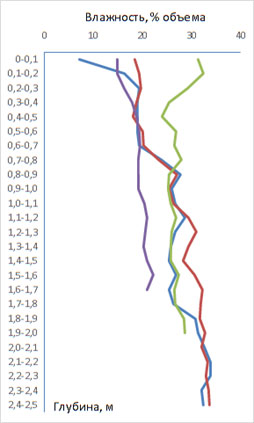The influence of long-term dynamics of groundwater levels on the winter redistribution of moisture in arable soils of the Ishim steppe
DOI:
https://doi.org/10.31251/pos.v7i1.250Keywords:
critical depth; cryogenic accumulation; root layer; soil-hydrological horizon; freezing of moisture; aeration porosity.Abstract
The aim of the study was to establish the influence of long-term dynamics of the groundwater level on the winter redistribution of moisture in arable soils of the Ishim steppe.
Location and time of the study. The Ishim-Irtysh steppe interfluve (Ishim steppe, Russia), 1986–1989 and 2002–2024.
Methods. Soil samples were collected during soil-hydrological field observations from the reference pits of arable soils. The soil and subsoil moisture content was determined by thermostat-weighing /in samples collected in the pre-winter period (the second - third decades of October) and at the end of the winter season (the third decade of March). The depth of the groundwater table was measured in the hand-drilled simultaneous with soil sampling for moisture measurement. The layer of cryogenic accumulation and the freezing moisture volume were determined by comparing moisture profiles in mid-October and in the third decade of March. Snow surveying was carried out in the third decade of March. The penetration depth of 0°C temperature was determined using exhaust thermometers.Results. Within the upland areas, during the second half of the 20th century the aquifer rose from various depths to the levels above the critical level. The economic activity was the main reason for the rise. In the early decades of the 21th century, as the groundwater table was above the critical depth, the groundwater level in summer and autumn began to be predetermined by the amounts of precipitation over the previous cold season of the year. The peculiarities of the winter redistribution of moisture in arable soils were found to be largely determined by the depth of groundwater in the autumn season. If in the upland soils the groundwater table was located in autumn at a depth of more than 4 m, which was typical for the 1980s, a layer of cryogenic moisture accumulation was formed below the horizons of intense and complete desuctive drying for spring grain crops, from a depth of 0.8 m. The moisture freezing volume did not exceed 30 mm. Migrated moisture practically did not participate in replenishing the post-vegetation moisture deficit in the upper 1-meter-thick layer of soil. If the groundwater in the second and third decades of October was detected at a depth of less than 4 m, which is typical for upland areas in the 21st century, a layer of cryogenic accumulation can be traced from a depth of 0.4–0.8 m, the volume of freezing moisture can reach 50 mm, and 25 mm in the top 1-meter layer. The frozen moisture in the top meter layer helps reducing the post-vegetation deficit, but promotes conditions for anaerobiosis in the second half-meter soil layer and acts as an “island of cold,” delaying the soil warming in spring to active temperatures.In soils with negative relief forms, the groundwater level during the period of field survey exceeded the critical level. Therefore, specifics of winter moisture profile redistribution in were similar to the established characteristics of this phenomenon in upland soils during the current millennium.Conclusions. The groundwater level in the soil and subsoils of the Ishim steppe uplands showed long-term dynamics under the influence of anthropogenic as well as natural factors over the past twenty years. The autumn depth of the groundwater table determines specifics of winter moisture redistribution in the arable soils of plakors: the higher the level, the greater the amount of moisture freezing is fixed, and the closer the cryogenic accumulation layer is located to the daytime surface.
Downloads

Downloads
Published
How to Cite
Issue
Section
License
Copyright (c) 2024 The Journal of Soils and Environment

This work is licensed under a Creative Commons Attribution 4.0 International License.






